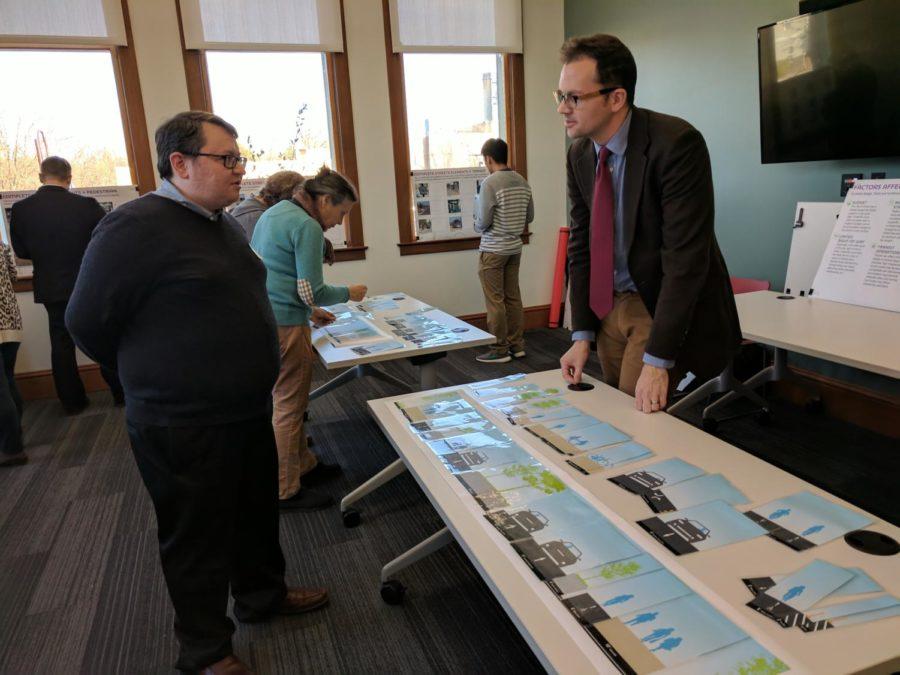City Holds Open House on Complete Streets Plan
Chris Anderson/Iowa State Daily
Adam Wood of Toole Design Group speaks with citizens at the Complete Streets Open House. The city of Ames is collaborating with Toole Design Group to draft the complete streets plan.
November 2, 2017
The City of Ames Public Works Traffic Division held an open house Thursday afternoon at the Ames Public Library in order to gather public input on the city’s “Complete Streets” plan.
As part of the 2017-18 Traffic Studies Capital Improvement Project, the city allocated funding towards the development of a “Complete Streets Plan.” The city contracted with Toole Design Group to help facilitate development of a plan that considers all forms of travel, in terms of road development.
Damion Pregitzer, traffic engineer for the city of Ames, was present at the open house to help define what complete streets means.
“I think our community wants to be a leader in transportation and complete streets is a big part of that,” Pregitzer said.
According to Pregitzer, complete streets is about ensuring more equal opportunity for all forms of travel in the city; whether it’s walking, biking, driving or taking Cyride.
“The point of the plan is to open up options for transportation,” Pregitzer said.
Pregitzer feels that because of safety or convience reasons, people are currently discouraged from taking certain forms of transportation in the city. The complete streets plan hopes to open up options for people wanting to take different forms of transportation.
However, this plan is a lot more complex than simply adding more bike lanes or walking paths. Pregitzer shares that the needs for a residential street is going to be very different than those of an arterial street with businesses on it.
The complete streets plan is currently in its early stage of committee organization and public outreach. The full plan is not expected to be developed until Spring/Summer 2018.
Public input will be a large part of the project from beginning to end, and Pregitzer hopes this open house will give them an incrementally better idea of what kinds of changes the public hopes to see.
“It’s not just about getting around, it’s about quality of life. It’s what do they want their town to look and feel like,” Pregitzer said.
Prior to public input, the city has been working with Toole Design Group, a consulting firm from Wisconsin, to aid in the process of creating the complete streets plan.
“Toole, they’re bringing in their national expertise. They don’t take on projects that aren’t multi-modal, that’s kind of the niche of their company,” Pregitzer said.
Adam Wood, a senior planner with Toole Design Group, was also present at the open house to help provide information about the plan to the public.
Wood shares that in addition to educating, they are also trying to figure out where the public’s priorities lie when it comes to transportation.
The organizers set up many interactive exhibits for those who came to the open house. They were encouraged to write down what they thought different streets should look like, as well as show preferences for what kinds of things they would like to see on streets.
“The primary thing so far that has come about is the need to have a good consistent process for making street design decisions,” Wood said.
Wood echoes Pregitzer’s sentiment that complete streets is not a one size fits all solution. Part of the information gathered at this open house was intended to determine the context of certain streets in order to decide what kind of changes need to be made.
“That’s what this process is looking to add some clarity on, some guidance,” Wood said.
The interactive exhibits, according to Wood, are also intended to determine different street typologies in the city.
“A street typology is kind of a starting point for street design,” Wood said.
The process the city and Toole Design Group is using is determining multiple cookie-cutter street typologies, such as residential or arterial. Then they hope to determine what kinds of things need to be done on these streets and adjust them based on the specific context of individual streets. For example, in a residential neighborhood, there might be a greater focus on aesthetics and pedestrian safety than on a more heavily trafficked road.
Wood also shared that citizens should look at the complete streets webpage at www.cityofames.org/completestreets, where polls may be added in the future.
Many citizens came to the open house to bring up things they were concerned about concerning transportation in Ames.
One citizen was David Kim, a high school student in Ames, who was concerned about traffic around the high school.
“At the high school there’s a T-junction where there’s a lot of congestion, so when I heard about this I came to see if this was trying to improve that,” Kim said.
Kim shared that he was happy to see the city acting on traffic issues and holding open houses looking for public input.







